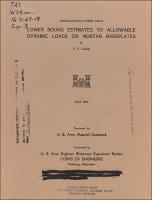Please use this identifier to cite or link to this item:
https://hdl.handle.net/11681/20804Full metadata record
| DC Field | Value | Language |
|---|---|---|
| dc.contributor | United States. Army Materiel Command | - |
| dc.contributor.author | Hadala, Paul F. | - |
| dc.date.accessioned | 2017-01-17T21:34:44Z | - |
| dc.date.available | 2017-01-17T21:34:44Z | - |
| dc.date.issued | 1969-03 | - |
| dc.identifier.uri | http://hdl.handle.net/11681/20804 | - |
| dc.description | Miscellaneous Paper | - |
| dc.description | Background: The firing of an 81-mm or 4.2-in. mortar exerts a very high intensity, very short duration inclined load on baseplates of these weapons. As a result of these high loads, relatively large vertical and horizontal displacements of the baseplate occur. To overcome this difficulty in current operations it is customary to use three rounds to seat the baseplate before firing for effect. This requires transport of additional ammunition and does not permit surprise (i.e., first round on target). In addition, in spite of the seating, the baseplate undergoes additional displacements as each subsequent round is fired. In some soils these displacements become intolerable either for reasons of aiming or crew safety. When this happens it is necessary to dig out the baseplate and reseat it before continuing the bombardment. | - |
| dc.publisher | U.S. Army Engineer Waterways Experiment Station. | - |
| dc.publisher | Engineer Research and Development Center (U.S.) | - |
| dc.relation | http://acwc.sdp.sirsi.net/client/en_US/search/asset/1049086 | - |
| dc.rights | Approved for public release; distribution is unlimited. | - |
| dc.source | This Digital Resource was created from scans of the Print Resource | - |
| dc.subject | Materials | - |
| dc.subject | Dynamic testing | - |
| dc.subject | Dynamic loads | - |
| dc.subject | Mortars | - |
| dc.subject | Ordnance | - |
| dc.subject | Soils | - |
| dc.title | Lower bound estimates to allowable dynamic loads on mortar baseplates | - |
| dc.type | Report | en_US |
| Appears in Collections: | Miscellaneous Paper | |
Files in This Item:
| File | Description | Size | Format | |
|---|---|---|---|---|
| MP-S-69-14.pdf | 5.06 MB | Adobe PDF |  View/Open |